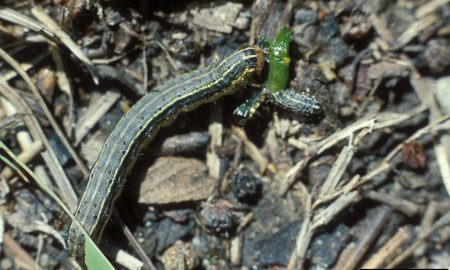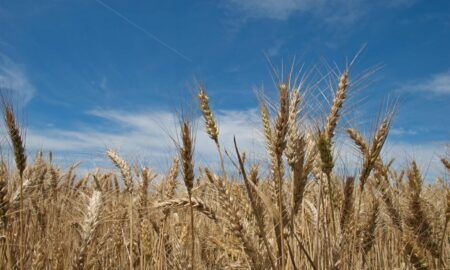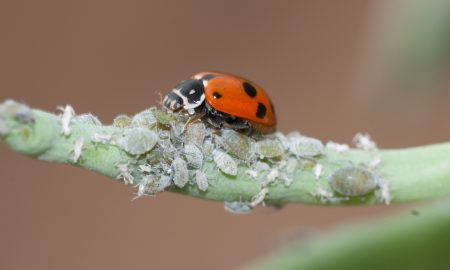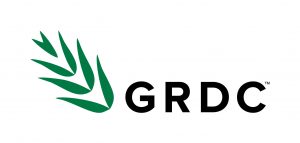With exceptional flights of native budworm moths having descended, when can we expect damaging grubs in pulses and canola?
Native budworm (Helicoverpa punctigera) moths are capable of migrating hundreds if not thousands of kilometres in spring.
With the help of growers and agronomists, budworm activity is being monitored through a network of traps in eastern Australia. Moth counts for the past two weeks are displayed in Table 1.
In the Victorian Mallee and some parts of the Wimmera, the numbers of moths caught are much greater than in the previous two seasons.
What does this data tell us?
Will greater moth numbers mean a higher budworm grub pressure?
It could do, but not necessarily.
For those moth eggs laid a few days before any rain events, research has shown that many will be washed off and destroyed. With the recent wet conditions experienced over much of Victoria and southern NSW, many eggs will perish.
Moth traps are most useful in showing peaks of activity across time in different regions, but are less useful in predicting relative activity across regions. For example, past experience has shown that despite higher moth catches in the Victorian Mallee than the Riverina, similarly damaging grub numbers can be found across the regions.
Based on the peak catches of moth activity, we can use a predictive model to estimate when eggs laid during major moth flights will hatch and reach the 3rd larval instar stage. It is advisable that susceptible crops are monitored once grubs reach this growth stage.
| Trap Location | District | 1st – 10th Sep | 11th – 16th Sep |
| Ouyen | Mallee, VIC | 125 | 942 |
| Swan Hill | Mallee, VIC | 131 | 181 |
| Kerang | Mallee, VIC | 183 | 306 |
| Rupanyup | Wimmera, VIC | 35 | 413 |
| Warracknabeal | Wimmera, VIC | 0 | 0 |
| Wonwondah | Wimmera, VIC | 2 | 75 |
| Forbes | Central West, NSW | 0 | 0 |
| Wagga Wagga | Riverina, NSW | 0 | 0 |
Forecasts
From the number of moths trapped and counted weekly (Table 1) we can assume that the first major flights of native budworm descended in Victoria around the 28th of August, and again on the 8th and 12th of September.
Table 2 shows the predicted dates of 3rd instars in major cropping districts:
| 28th Aug | 8th Sep | 12th Sep | |
| Ouyen | 28 Sep +/- 4 days | 8 Oct +/- 4 days | 10 Oct +/- 4 days |
| Swan Hill | 1 Oct +/- 5 days | 9 Oct +/- 5 days | 12 Oct +/- 5 days |
| Kerang | 2 Oct +/- 5 days | 10 Oct +/- 5 days | 12 Oct +/- 5 days |
| Elmore | 8 Oct +/- 5 days | 15 Oct +/- 6 days | 18 Oct +/- 5 days |
| Horshm | 10 Oct +/- 6 days | 17 Oct +/- 6 days | 19 Oct +/- 5 days |
| Wagga Wagga | 12 Oct +/- 6 days | 18 Oct +/- 6 days | 20 Oct +/- 6 days |
| Colac | 14 Oct +/- 7 days | 22 Oct +/- 7 days | 24 Oct +/- 6 days |
Our advice
Monitoring crops should begin from early podding, particularly after the predicted date for 3rd instar larvae.
The continued migration of moths through spring is probable.
Given the wet conditions in many areas, it is likely that some pulse crops will continue to remain attractive to budworm for longer.
Monitor pulse and canola crops regularly using sweep nets; it is important to sample representative parts of the entire paddock prior before making a control decision. Taking multiples of 10 sweeps within at least five locations in a paddock is recommended.
For more information on management, including economic thresholds see our native budworm PestNote.
Acknowledgements
Trap operators
Brad Bennett – Consultant, AGRIvision (Victorian Mallee)
Jim Cronin – Agronomist, Landmark (NSW Central West Slopes and Plains)
Bill Gardner – Agronomist and grower (Victorian Wimmera)
Shayn Healey – Agronomist, Crop-Rite Pty Ltd (Victorian Mallee)
George Hepburn – Agronomist, Tylers Hardware & Rural Supplies (Victorian Wimmera)
Damian Jones – Agronomist, Agronomic Results (Victorian Mallee)
Jake Leith – Agronomist, AGRIvision (Victorian Wimmera)
David White – Agronomist, Delta Agribusiness (NSW Riverina)
Cover image: Photo by Andrew Weeks, Cesar Australia





